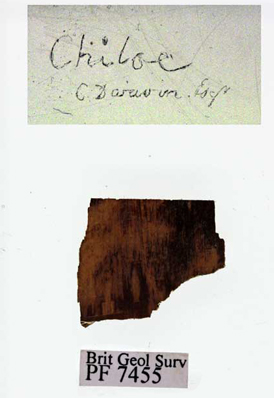Darwin’s Lost Fossils – A Cabinet of Curiosities
Dusty Cabinet Provides Insight into the Formative Years of Charles Darwin
Charles Darwin, was an English naturalist who significantly influenced modern scientific thinking when he published his theory concerning natural selection in 1859. As a young man, Darwin travelled on the HMS Beagle as the resident naturalist and companion to the ship’s captain. The five year voyage impressed upon the young Darwin a sense of the natural world’s beauty and subtlety. He began to pose searching questions about the complex relationships between organisms, the Earth’s structure and anthropology that led him to question the accepted doctrine regarding the origins of life.
Charles Darwin
His observations and meticulous notes provided Darwin with the materials needed to develop a new theory that species evolved by a process of natural selection. Any materials, notes and specimens collected by Darwin on his epic journey are extremely precious. To discover an entire cabinet of prepared fossil specimens collected by the great man himself and a number of Darwin’s peers is truly remarkable.
For one young research student, an examination of an old cabinet stored in a “gloomy corner” of the British Geological Survey, has provided an astonishing insight into the formative years of one of the most important scientists of the 19th century.
Howard Falcon-Lang, a palaeontologist at Royal Holloway (University of London), discovered a total of 314 prepared slides stored in an old wooden cabinet. The slides represent fossil specimens, many of which were collected by Darwin during his voyage on the Beagle.
One of the Fossilised Slides and Darwin’s Label
Picture credit: British Geological Survey
Fossil Wood
This slide shows a piece of fossil wood that was collected from the Island of Chiloe, Chile in 1834, probably by Darwin himself. Darwin’s label can also be seen. The specimen dates from approximately 40 million years ago (Palaeogene Period).
The slides were discovered at the British Geological Survey’s storage site, located at Keyworth, Nottinghamshire (England). The British Geological Survey is home to more than three million fossils collected over the 180 years or so since the organisation was founded. Usually the specimens are catalogued with great care and precision, however, this collection, compiled by the Victorian botanist Joseph Hooker, a close friend of Darwin, was not catalogued correctly and had lain forgotten in a dark, and dusty corner.
Hooker had been given the job of sorting out this part of the collection when he worked for the British Geological Survey in 1846. Unfortunately, before he could complete the task, he was offered the chance to join an exhibition to the Himalayas, so he simply stored all the slides in a cabinet.
Slides
The slides are of fossil wood and fungi. The slides were made by cutting very thin sections through the fossils and then polishing them so that they can become almost transparent, revealing their internal structure. This was one of only a few techniques known to the Victorian scientists for looking at the internal structure of fossils. In those days, X-ray machines, CAT scans and the like had not been invented, so the only way that the internal structure of a piece of petrified wood could be studied was by cutting slices off the actual fossil material.
The highly polished specimens were then placed between two sheets of glass so they could be studied under a microscope. These fascinating specimens provide an insight into the study of fossils in the 19th Century. The cabinet contains material collected by Darwin, Hooker and a number of other notable scientists including William Nicol, a pioneer in the study of the internal structure of rocks.
Using a torch to illuminate the contents of the dark cabinet, the first slide that Dr Falcon-Long picked up had the label “C. Darwin Esq.”
Dr Falcon-Long commented:
“It took me a while just to convince myself that it was Darwin’s signature.”
He added:
“It was quite an important and overlooked specimen. There are 100 million-year-old fossil trees from the latter age of the dinosaurs. It’s real Jules Verne stuff, and scientists are only now starting to study it and understand its scientific importance.”
The cabinet was moved to the British Geological Survey’s offices in Charing Cross (London) in 1851. It was transferred to the Geological Museum (South Kensington – London) in 1935 before being moved to the Nottinghamshire site. However, in all that time, as far as anybody knows, the cabinet was never opened.
Dr John Ludden, of the Geological Survey, said:
‘This is quite a remarkable discovery. It makes one wonder what else might be hiding in our collections.”
Who knows what else may lie, awaiting discovery amongst the vast number of specimens stored at the British Geological Survey’s various locations.


